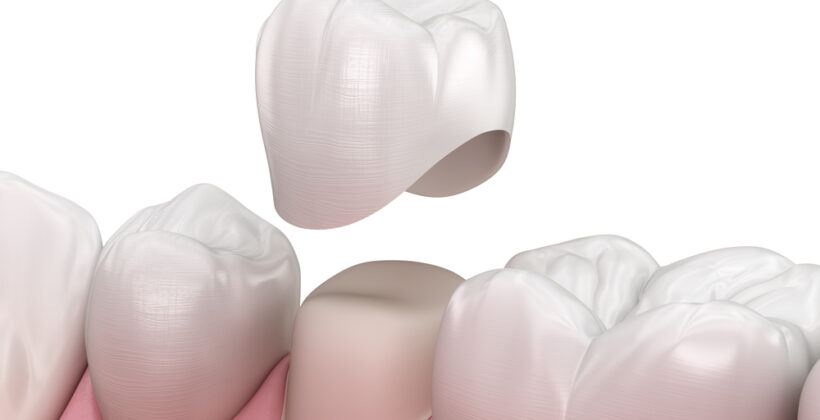Also called caps, dental crowns restore damaged, treated, or unattractive permanent teeth. The material used to fabricate a crown depends upon the forces the restoration will encounter when chewing and biting, as well as the patient’s preference.

Ceramic crowns look natural but cannot endure crushing pressure, so they work well for front teeth. A bit stronger, porcelain-fused-to-metal (PFM) crowns can improve front teeth, as well as molars. Because of their strength, all-metal crowns are the gold standard for restoring molars, though a molar restored with a zirconia crown can endure intense pressure while maintaining the white, natural look of tooth enamel.
In today’s blog, we’ve identified the six primary uses for dental crowns. Each of the cases below is explained in greater detail within the article, so read on to learn what dental crowns do and why you may need one.
- Reinforce Decayed, Weak, or Cracked Tooth
- Restore Worn-Down Teeth
- Anchor Dental Bridges
- Cover a Tooth after RCT
- Complete a Single Dental Implant
- Transform Stained, Misshapen, or Oddly Spaced Front Teeth
Crowns Reinforce Decayed, Weak, or Cracked Tooth
The primary purpose of a dental crown is to reinforce the structure of a tooth, which in turn restores comfortable function and proper occlusion (bite). Occlusion refers to how upper and lower teeth fit together when the mouth is closed.
Dental crowns restore teeth that present with:
- Decay that a filling won’t adequately restore
- A crack or deep chip
- Horizontal cracks at the base of a tooth
- Small, weblike cracks called crazing
- Insufficient structure or malformation
Restore Worn-Down Teeth
An imbalance occlusion, or malocclusion, can lead to addition wear and tear on teeth, as well as restorations, so proper occlusion is important to overall good dental health. Oftentimes, patients with malocclusion will clench and grind their teeth, a condition known as bruxism. Clenching and grinding teeth contribute to the wearing down of enamel, which further destroys good occlusion.
Without treatment, malocclusion and bruxism can contribute to the development of TMJ disorder, or TMD. This condition causes headaches, jaw aches, earaches, toothaches, tingling fingers, and locking of the TMJ joints.
Anchor Dental Bridges
A dental bridge replaces one tooth or up to three teeth in a row. As the name implies, a dental bridge “bridges the gap” between healthy teeth. The structure of a dental bridge is: a crown, replacement tooth/teeth, and another crown. The crowns anchor to healthy teeth so that the replacement teeth can bite or chew without movement.
Cover a Tooth after RCT
An internally infected tooth requires root canal therapy, or RCT. A root canal procedure involves making an entry point into a tooth to access the pulp within its innermost chamber. After extracting the infected pulp, the dentist inserts gutta-percha, an inert material that strengthens the tooth. Afterward, a dental crown is often applied to seal and reinforce the treated tooth.
Complete a Single Dental Implant
Instead of replacing a lost tooth with a bridge, some patients prefer an independently anchored dental implant. An implant is a small, screwlike post made of biocompatible metal or ceramic. The implant dentist anchors the post into the jaw so that it acts as a replacement tooth root. After attaching an abutment, the implant post is topped with a strong dental crown.
Transform Stained, Misshapen, or Oddly Spaced Front Teeth
For patients who do not want bonding or veneers, or for front teeth previously treated with a restoration, all-ceramic dental crowns offer an esthetically pleasing transformation for front teeth. Common cosmetic concerns that warrant a dental crown on a front tooth are:
- Permanent stains
- Wide spacing
- Uneven spacing
- Chips
- Misshapen or twisted tooth
- Undersized tooth
- Uneven tooth
Call Today for a Dental Crowns Consultation
If you have a failing or loose dental crown, or you’re suffering from an acute toothache, call Dental Care of Lombard today at 630-629-5700 to schedule your dental appointment. Dr. Julie Glud will discuss your concerns, provide a comprehensive oral examination, and share her findings with you. She’ll present her recommended treatment plan with a thorough explanation and answer all of your questions.

